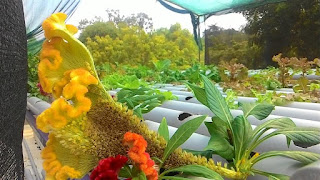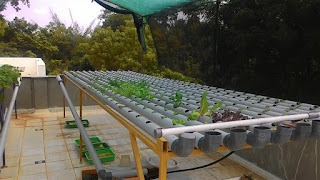I have shared this article by Roger H. Thayer because I think it is very well said and may help clear up some questions about organic vs. inorganic growing.
I'd like to have a dollar for each time I've been asked, "Is it organic?", since I started in the hydroponics business in 1972, I'd be rich! Is hydroponics organic? Is it chemical? What are the similarities and the differences? These questions have never really been answered to the satisfaction of most people as evidenced by the fact that I am asked the same questions today as often as I was nearly 20 years ago. Many people are confused by the word "organic" as it means different things to different people.
To the farmer, the word organic means no pesticides or herbicides. No potentially toxic or hazardous materials are to be used on crops to control bugs, weeds and diseases. To the gardener, the word usually means all of these things, plus that no unnatural or manmade chemicals are to be used. Only "organic" fertilizers and natural controls. They must: be made by nature, not by man.
To the chemist, on the other hand, the word "organic" means something totally different. In chemistry there are two distinct branches: inorganic and organic chemistry. Inorganic chemistry deals with non-living materials.
Organic chemistry focuses on the carbon and carbon containing compounds, typically associated with life. Biologists and botanists, and others who deal with the life sciences, are stuck in the middle. When they deal with chemists and other scientists, they have to adhere to the chemical definition of organic. When they talk to the farmer or gardener, they have to talk in different terms. To them, organic means "natural," not carbon based. They can say one thing, but really mean something else.
There is really no difference between an atom, mineral or the element itself. What matters is whether or not they are in a form that is non-harmful and that can used by plants. If so, they are beneficial whether natural or manmade. Plants do not take up carbon at the roots, they get all they need from the CO2 in the air, so the term "organic gardening" is confusing. The same minerals are needed in either hydroponic or organic growing. These minerals are provided to plants in the organic garden as they are released from organic matter by the action of microbes, worms and bacteria. In hydroponics, these same elements are provided by water soluble mineral salts.
In hydroponics, mineral elements are provided by the use of mineral salts. These may be either naturally derived of manmade, but most have been purified and processed so that they are water soluble and in a form that can be used by plants. Many start out as mined minerals or naturally concentrated deposits that are dissolved and processed into compounds with a definite molecular structure and composition. In the refining process, these mineral salts are usually purified to remove heavy metal contaminants and toxic substances that could harm plants or people. Since the chemical composition is precisely known, different mineral salts can be combined to form a balanced hydroponic nutrient. When dissolved in the proper proportions with a good quality water, a hydroponic nutrient solution can provide all of the mineral elements needed for plant growth without soil. By its nature, the hydroponic methods eliminates much of the uncertainty and guesswork found in organic growing. Some adjustments are normally made for proper pH, controlling nutrient concentrations (parts per million) and to maintain balance between the nutrients provided. These are usually easy adjustments and within the control of the grower. In a well-built hydroponic installation, all conditions are controllable so optimum plant growth can be achieved, even surpassing nature.
But is it organic? Can a hydroponic plant nutrient be classified as organic? Probably not, unless you go back to the chemical definition of the word, that is a substance that contains carbon. By this definition, many "chemical" nutrient formulas would be considered organic. These include the chelated trace elements as well as urea, which contains carbon in the form (NH2)CO2. It is also possible to define a hydroponic nutrient solution as organic by drawing on the definition many people use that organic is "natural".
Most of the mineral elements used in hydroponics start out as mined rock or mineral deposits which are as natural as the earth itself. The important point is that it is not the elements that are different in organic and hydroponic growing, it is how these elements are obtained and delivered to the plant.
Pros and cons. There are definite advantages and disadvantages to both organic and hydroponic growing. land is still available for conventional agriculture. With proper techniques and care, organic growing can yield good, nutritious crops on a large scale with minimal expense, although it can be labor intensive. Organic growing has an element of uncertainty, as already mentioned, but with care and knowledge, that can be kept to a minimum. Still, optimal mineral and element composition is going to involve guesswork unless expensive chemical soil analysis is routinely done and soil amendments are used to correct deficiencies. Most of the amendments used in modern agriculture happen to be the exact same mineral salts that are used in most hydroponic nutrient formulas. The advantages of hydroponic growing are increased yield through complete nutritional and environmental control, the absence of competing weeds and soil-borne diseases, increased crop density and reduced water consumption. With recycling systems, hydroponics uses one-tenth the amount of water used by irrigated agriculture. Growing media are easily sterilized and conditions can be altered quickly to suit specific crops or the growth stage of a particular crop, such as during flowering or fruit production.
The main disadvantage is the initial set-up cost. The cost of a good installation is fairly high, but if quality materials are used that cost can be spread out over many years. What about using hydroponic nutrients in an organic or soil garden! There are many advantages to this kind of hybrid application, combining organic compost with hydroponic nutrients similar to Mittleider Gardening. Care must be taken not to overdose the plants with such a system. If a full-strength chicken manure is used with a full-strength hydroponic solution the plants can be burned. Handled properly the system could eliminate mineral deficiencies. Plants grow faster and healthier as long as pH, drainage and water/nutrient retention are adequate. Because the plants are healthier they are able to ward off insects and diseases, further enhancing yield.











































